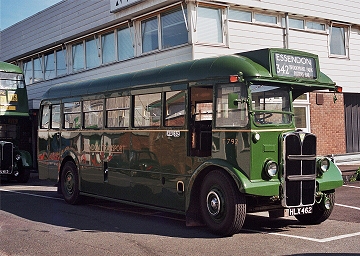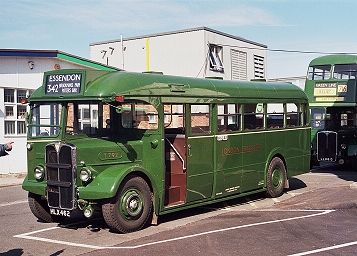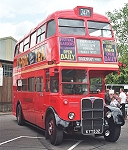


Behind it was Greenline RT3254, one of the batch of RTs built for the Greenline services between Aldgate and Romford, and treated to Greenline livery without adverts. Unlike Greenline RFs these RTs had no Greenline extras other than the paint scheme - no deep cushions or luggage racks. RT3254 has been restored to Greenline condition in private preservation, and gleams like a Greenline should.
Red RT624 is another special RT - inasmuch as it was the last to run in ordinary London Transport service, back in April 1979. It had started off as a green Country Area bus in August 1948 with a Weymann roofbox body but gained a standard body at an early overhaul. It went to the Central Area, with a red body, from overhaul in 1965. After withdrawal in 1979 it had been preserved in the Midlands. Ensignbus bought it in 2004 and restored it to 1979 appearance (complete with period adverts) in time to use it on various London routes during the Routemaster farewells. It too gleamed in the sunshine.
For a bus to reach those parts that other buses could not reach London Transport had its Heineken Bus, the Guy Special. A twenty-six seater, it was LT's only one-man operated bus amongst the postwar designs (at first), and was only allowed to work in the Country Area. GS13 was sitting quietly wearing blinds to remind people of the upcoming Hemel Hempstead Running Day.
RF406 arrived, purring up the slope from Darkes Lane. This was LT's main postwar big saloon design: a forty-one seater in the maximum length allowed by Law: 9.0m, the same as a short 29-seater Dart. Originally all operated by driver and conductor, they were mostly later converted for one-man operation, as crewed single-deckers could not carry enough passengers to pay their way with the cheap fares of the time.
I went down onto Darkes Lane - the main road past the station, where the bus stops for the day had been erected.
Not that the signs stopped cars parking there. GS17 was sitting on the stop ready to go to Essendon once its driver returned.
I found my way to the Manor Road parking place, where the static display of RTs was to be held
- and found that just Greenline RF269 had arrived so far.
But the shining coach represented the standard Greenline vehicle of the 1950s
and beyond: comfortable and reliable.
I went looking for a toilet. None in the carpark. None in Sainsbury's. None at the station.
The station was closed for the renewal of the canopy. Trustline's Dart Evolution DML4 was at the station,
but I cannot remember whether it was on ordinary Sunday service or Rail Replacement.
Back on the street RF308, representing the Country Area bus version of the saloon, was arriving,
ready for the 342. This particular RF started as a Country Bus (RF527) and was converted to Green Line to receive its new number.
Later it reverted to Country Bus status when the Routemaster Coaches took over its Greenline work,
and went to Chelsham to displace GSs.
More buses had arrived, and I made another circuit of inspection. RF486 had now been fitted with blinds for the 242, the red RF route of the day. RMC1476, the only Routemaster allowed on this older-buses day, was having its blinds for the day fitted. Now parked was an example of the very early postwar roofbox RTs. RT190 has been restored to early livery, including the cream upper window surrounds, restricted blind displays and the white spot on the tail. It does sport too the legally required reflectors (mandatory from 1954), as well as modern rear light clusters. It also appears to have a restored power auxiliary socket flap under the drivers step. And a fleet number to match its early body (this bus was withdrawn as RT1173).
Another early-condition roofbox RT was RT3496, but in Country Area green and cream, with restricted blind displays. The high number is a reflection of the way that early bodies received more or less random fleet numbers on emerging from Aldenham overhaul.
RF457 arrived too, already dressed with 242 route blinds.
Representing a yet earlier episode in the RT history was RT113, one of those built early in the war years. These reverted to a traditional body-chassis relationship, with the platform carried on the chassis rather than cantilevered from the body like RT1 and the postwar RTs. The bodies were wood-framed too. But RT113 has been substantially rebuilt to avoid the worst ravages of passing time, and wears wartime livery of red and white with grey roof and white blackout trims. Just one headlamp too. Most striking, for most people, is the rear roofbox. Today it was to operate on a Country Area route, as seven green and one red members of the class did from Hertford in 1955-57.
RF4 was also notably different. One of the first RFs built in 1951 for the Festival of Britain, it was so urgently needed that LT could not wait for a legislation change to permit 30ft four-wheelers. So it was to the older, shorter maximun length, with a correspondingly shorter wheelbase. Made for tours and private hires, it sports cant-rail windows (with venetian blinds), and a specialised tours livery of green and grey, with red fleetnames.
Also scheduled for tour work today was RF281, looking smart in the modernised Green Line style adopted in 1967, with dual headlamps, aluminium trim, refurbished interior and lime green cummerband.
An altogether different beast was represented by BL49, just arriving. One of the RF's replacements, the Bristol LH was a lighter, noisier, altogether less-refined bus. But with an attraction all of its own. Today it would operate extras on the 242.
It was followed in by another of Claire Green's buses, another modernised Greenline, RF48.
Having completed the round of service buses, I was back at T792. I enquired when they were going out.
Almost immediately, was the reply, on a 313 to St.Albans. I asked if I might join them, and climbed aboard...
 Part Three: St.Albans and back
Part Three: St.Albans and back
Photos by Ian Smith. Click on any of them for a larger picture.
 Back to Ian's Bus-stop
Back to Ian's Bus-stop
 Part One
Part One
 Part Three: St.Albans and back
Part Three: St.Albans and back